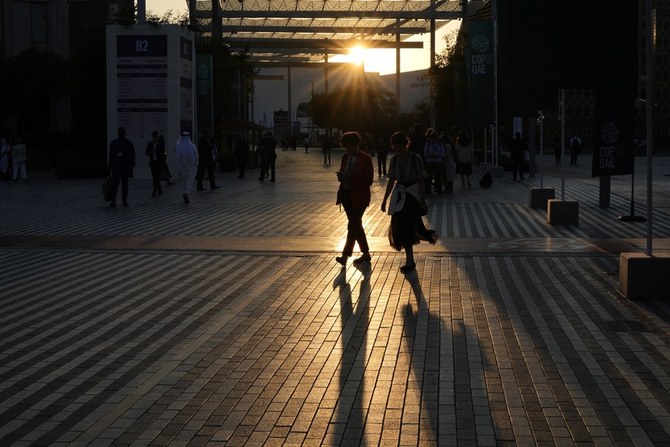The road to net zero runs through the Middle East

https://arab.news/nmmku
With global carbon dioxide emissions reaching a record high of 36.8 billion tons in 2022, the urgency to combat climate change is palpable.
Concurrently, geopolitical uncertainty and rising energy demand, projected to grow 25 percent by 2030 and 50 percent by 2050, exacerbate the challenges of energy security and affordability. Remarkably, almost 800 million people still lack access to basic electricity.
The Middle East’s role is pivotal in the global energy transition, bolstered by its potential for renewable energy and substantial oil and gas reserves. These factors will be central at the UN climate change conference in the UAE for COP28.
Despite the Middle East and North Africa region’s reliance on fossil fuels, there is a unique opportunity to decarbonize hydrocarbon production and diversify the energy mix, potentially becoming a net exporter of low-carbon and renewable energy.
Saudi Arabia targets 50 percent renewable energy by 2030, Oman 30 percent, Qatar 20 percent, and the UAE 44 percent by 2050. Achieving these goals necessitates addressing challenges, particularly in modernizing the electrical grid infrastructure.
The Gulf Cooperation Council’s transmission grid, primarily designed for centralized power generation from thermal power plants, must evolve to accommodate decentralized renewable energy sources like solar and wind. This shift necessitates technologies such as synchronous condensers to manage load and power frequency fluctuations in an increasingly decentralized generation landscape.
Grid stabilization is crucial, especially with the unpredictable nature of solar and wind power. Technologies like Flexible Alternating Current Transmission Systems enhance transmission line capacity, contributing to grid reliability by improving voltage stability and regulation.
Furthermore, significant investment in energy storage, including electrochemical batteries and hydrogen-based solutions, is required to ensure a consistent power supply. Renewable energy storage also promotes industrial decarbonization through sector coupling, expediting the green energy transition.
Acknowledging the ongoing role of fossil fuels, decarbonization remains imperative. The GCC’s advancement in carbon capture and storage projects is noteworthy, with facilities capable of capturing around 3.7 million tons per annum, representing about 10 percent of global annual carbon dioxide capture. Ambitious targets set by Qatar, the UAE, and Saudi Arabia emphasize the region’s commitment to CCS.
Several CCS pilot projects are also taking place across the region.
Saudi Arabian Oil Co. is currently testing technology that captures 800,000 tons of carbon dioxide per year, compressing and injecting it into an oil field. Aramco’s conversion technology uses the captured carbon dioxide to create useful polymers, such as plastics, with just one-third the carbon footprint of conventional polymers.
Direct air capture projects are gaining traction as well. Saudi Aramco, for example, recently announced a partnership with Siemens Energy to develop a small-scale DAC test unit. The test unit will be built in Dhahran and is slated for completion in 2024.
Innovative technologies and partnerships like this will be vital to accelerating decarbonization, particularly in industries deemed “hard to abate” or that cannot easily be electrified, such as steel, cement and chemicals.
The Middle East’s oil and gas infrastructure positions itself uniquely for clean hydrogen and e-fuel production.
Saudi Arabia’s hydrogen and ammonia production targets and those of Oman, the UAE, and Qatar signify a substantial shift toward green energy.
Saudi Arabia has plans to produce 650 tons per day of hydrogen and 1.2 mtpa of ammonia by 2025 for export. Oman and the UAE’s Abu Dhabi National Oil Co. have targeted 1 mtpa of green hydrogen output by 2030, while Qatar has aimed to produce 1.2 mtpa of blue ammonia by 2026.
The region’s aspirations for green hydrogen production will require a corresponding build-out in renewable generating capacity.
The Middle East Institute estimates that producing 1 mtpa of green hydrogen would need roughly 6-9 gigawatts of electrolyzing capacity and as much as 16 GW of renewable energy capability. This demand would require renewable energy capacity in the GCC to increase to nearly 40-60 GW by 2030, which is almost a sixtyfold increase from where it stands today.
In summary, we have reached the point of “now or never” when mitigating the threat of climate change.
The world, particularly the Middle East, can no longer wait to take decisive action to decarbonize.
The region can play an integral role in helping the world achieve carbon neutrality by serving as a clean energy exporter and an incubator of green technology development, innovation and new partnerships.
The energy transition must be embraced as the most significant socioeconomic and environmental transformation since the Industrial Revolution. After all, energy is not merely a commodity.
The Middle East is poised to be a global clean energy exporter and a hub for green technology development and its journey to carbon neutrality is critical.
The success of this transition hinges on a pragmatic approach, requiring all parties to balance decarbonization and sustainability with security and affordability. The Middle East’s journey is a microcosm of the global challenge and opportunity in achieving a sustainable, decarbonized future.
COP28 can make a difference if all parties have the will to change, remove their reservations and prejudices, and finally move the needle!
• Dietmar Siersdorfer, managing director of the Middle East at Siemens Energy









































